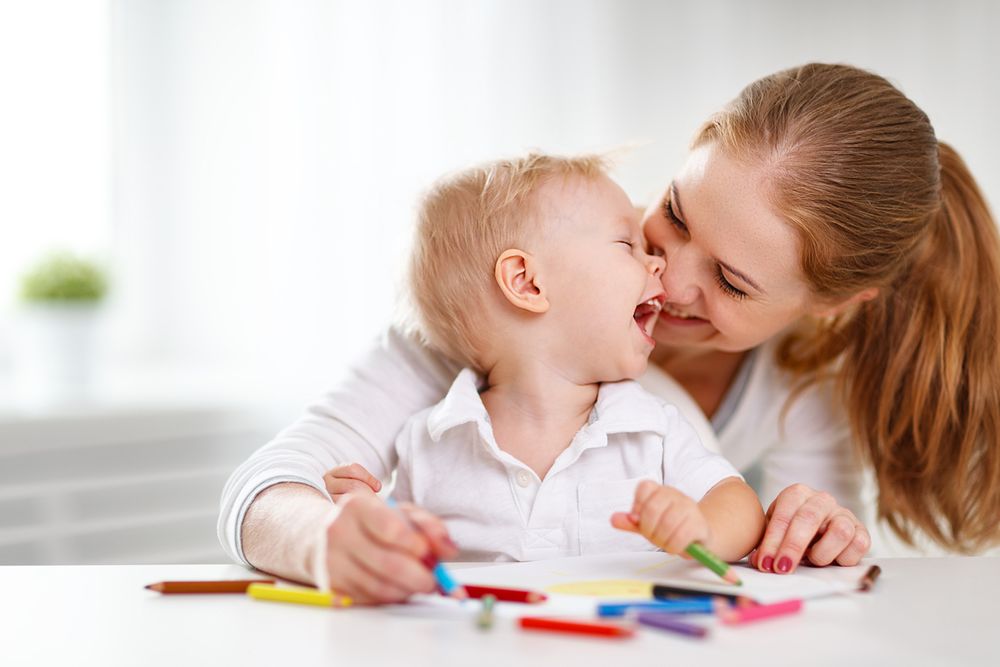How to build your child's fine motor skills
Published on Wednesday, 10 July 2019
Last updated on Tuesday, 31 December 2019

Whether they're grasping a toy or gripping a pencil, fine motor skills are an important part of your child's physical and cognitive development. These skills involve the coordination of the brain and muscles to make small, yet important, movements. By honing their hand-eye coordination and using the little muscles in their fingers, hands and wrists, fine motor skills allow your child to grip, stack, thread, press, mould, cut, write and much more.
As they learn essential life skills, fine motor skills are needed for many day-to-day tasks, such as brushing teeth, buttoning clothing and using cutlery, and they're a big part of school too, as children learn to do things like write, play an instrument and type on a keyboard.
To help your child get a grip in their early years, here's how you can promote small muscle movements at home.
What materials are great for fine motor skills?
Hands On As We Grow contains many projects that use everyday materials to develop fine motor skills. Taking into account your child's age, here are some materials they say are easy to come by and excellent to use:
- Pompoms - build hand-eye coordination and can be picked up, moved, and sorted
- Buttons - can also be picked up and sorted when loose, but real finger strength and hand-eye coordination comes with the buttoning and unbuttoning actions
- Paper clips - are great for finger movement and manipulation as older preschoolers or first years practice sliding them onto paper
- Eye-droppers - develop your child's pincer grip, using their forefinger and thumb to suck and squeeze liquid
- Play dough - easy to make and perfect for kneading, pressing, rolling and squeezing
- Plastic tweezers - involve lots of hand-eye coordination and control to shift other items
- Kitchen tongs - a larger version of tweezers to build hand strength and control, they're also a fun way for your child to put their toys away after play
- Clothes pegs - build finger strength as youngsters use their pincer grip to prise them open and shut
- Rubber bands - also build finger strength by exerting tension and opening up the small muscles
- Pipe cleaners - can be threaded, poked, bent and wound around other items to hone fine motor skills
- Straws - can be used as beads for threading activities or stuck into play dough
- Nuts and bolts - can be tightened and loosened, and made of plastic or metal
- Stickers - get peeled off the sticker sheet and pressed onto paper, and if this is too tricky for young children, you can remove the plain background of the sticker sheet to leave just the stickers
- Plastic syringes - (not the type with needles!) require hand control to fill and squeeze. They can be used for fun water play or preschooler painting.
Remember, some of the above materials are small. Before you hand your child a loose item, judge whether they're old enough to play with it and, whatever their age, make sure you supervise their play.
In NZ, the safe size for children under the age of three is 3.1cm x 5.1cm, so things like buttons, nuts and bolts aren't safe for little people.
18 activities to hone fine motor skills
Aside from the above materials, there are lots of other ways to get small muscles moving and build dexterity and hand-eye coordination.
Here are 18 fun activities to try at home:
- Drawing and colouring - try this pasta drawing challenge
- Painting - paint rainbows with marshmallows and toothpicks
- Cutting using age-appropriate scissors - practice snipping flowers, play dough, cooked spaghetti and, of course, paper!
- Tearing paper - make some torn paper texture art
- Doing puzzles - Jumpin' Jacks Toys stocks puzzles for babies and kids
- Water play - toddlers can use mini-basters and pouring utensils
- Threading beads - make spaghetti bead towers in play dough
- Lacing shoes or card - try this paper plate apple lacing activity
- Hammering - this wooden peg and hammer set is for ages 2+ and made in NZ
- Posting items - DIY this colourful matchstick fine motor toy
- Sorting - this ABC letter sort activity is great for toddlers' fine motor skills and literacy
- Finger puppets - combine craft and puppet play with these easy pipe cleaner finger puppets
- Stacking blocks
- Building with LEGO
- Unlocking and unlatching - you can buy or DIY a locks, latches and hinges board
- Helping with food preparation - little fingers can tear lettuce, peel boiled eggs or pick off strawberry stalks
Fine motor skills are very important for your child's development and there are lots of small things you can do – and use – to build their abilities in their early years. Have fun!
Reference
Understood
Related Articles

Your child's mental health
Most parents can spot a gunky eye or a grazed knee from a mile off, but when it comes to a youngster's mental health, it seems that many mums and dads are in the dark.

7 life skills that will help your child succeed
The skills that will help your child thrive in their current and future lives; and how you can nurture these skills in your youngster's day-to-day activities.

Screen time - Why less is best for preschoolers
Tablets and TV can be a tempting way to entertain preschoolers, but according to recent research, too much screen time can do more harm than good.
